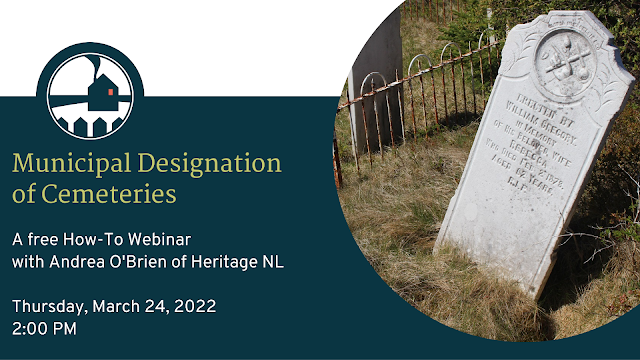Our last blog post on Charles Ollerhead and the Heart's Content Salvation Army cemetery inspired questions on who Charles Ollerhead was, and the history of this tiny, one-marker cemetery. More information was found in Connecting the Continents by Ted Rowe, an excerpt of which is available below.
 |
| Connecting the Continents by Ted Rowe. |
Excerpt below was taken from: Rowe, Ted. Connecting the Continents. St. John’s: Breakwater Books Ltd.,
2009-04-21. Page 96-97, with the authors permission.
"The Salvation Army first appeared in Heart's Content in 1891, striking a chord with a young cable operator dedicated to the cause. Newcomers to Newfoundland, the Army brought a religious style especially appealing to those Methodists nostalgic for the lively, unrestrained prayer meetings of their earlier days. Carried on a wave of unabashed evangelical fervour, the Army swept through the outports and attained official standing as a religious denomination, which, among other things, allowed it to operate its own schools in a government-supported denominational education system.
At first the congregation of St. Mary's, still mindful of the Wesley upsurge, did not know quite what to make of this new intrusion, but a congregational meeting in January 1892 found them ready to close ranks:
Mr. Charlton asked who were members of the Church. Rev. Chairman stated that any persons who connected themselves with any other church or sect or enrolled themselves as members of S Army could not be members of the Church and pointed out that the Rector was not bound to bury a corpse simply because the friends of the deceased wished it. After some remarks by Messrs John Farnham, Gaden Rendell & others Mr. Charlton proposed, Mr. J. H. Moore seconded that persons joining any other church or enrolling as member of S Army be not allowed to use St. Mary's cemetery. Carried.
 |
Headstone of Charles Ollerhead, buried in the Salvation Army Cemetery
in Heart's Content. Photo courtesy of Ted Rowe. |
No dithering as far as the Salvation Army was concerned. The Army's stalwart in Heart's Content was Charlie Ollerhead, a 20-year old Anglo employee whose father had broken away from the Church of England and married into the Methodist side of the Hopkins family. A bachelor with some spare time on his hands, Charlie Ollerhead became passionate in the cause. He volunteered as secretary of the Salvation Army in Newfoundland and spent his summer holidays helping out at headquarters in St. John's. His zeal is apparent in a small item penned for the Army's Canadian newspaper, The War Cry:
One would think it an impossibility to have a public S.A. banquet in Heart's Content, the people seem to be so much opposed to us, but the Captain's faith ran high, and six of us took up our cross to beg (without a trial there's no denial), and the Lord opened the peo- ple's hearts and they helped us exceptionally well.
We have no real barracks here, and we tried to get a hall, but failed to obtain one. We had with us Capt. Hoddinott and Bro. Howell, with his cornet and guitar, from Carbonear, also officers from Hant's Harbour and Scilly Cove. We had a nice crowd. The musical jubilee went with a swing. I believe everyone enjoyed themselves, and the unsaved had another chance to get ready to enter into the marriage supper of the Lamb, but none would accept the invitation...We realized the nice little sum of thirty dollars…
The Army held their first meetings in a fishing shed on the Rockwood plantation, nicknamed the "tar-pot," where they attracted a contingent of men from Scilly Cove. By 1893, the Scilly Cove people branched off with a corps of their own. In Heart's Content a new barracks was established near the Main Brook.
Charlie Ollerhead's soldiership was cut short by ill health in 1896. In March, the station superintendent advised that he take a fortnight off and noted that he would be wise to "discontinue his more active operations in connection with the Salvation Army, public speaking, shouting, excitement and late hours not being good for him." Anglo's general manager in London ruled that his occupations outside combined with his duties were too much, and he would have to resign one or the other. Ollerhead worked on and off until June when he was diagnosed with tuberculosis. He died in November. Forewarned by the Church of England policy on burial space, the Army had secured land for a cemetery on the barrens just behind Rowe's Bank. Charlie Ollerhead was the first and only soldier laid to rest there. After his passing the Army failed to gain a firm footing in Heart's Content and departed for good in the 1930s. Today, their tiny cemetery with its single gravesite is the only reminder that they were ever there."
Learn more about the history of Heart's Content in Connecting the Continents by Ted Rowe (2009).













































